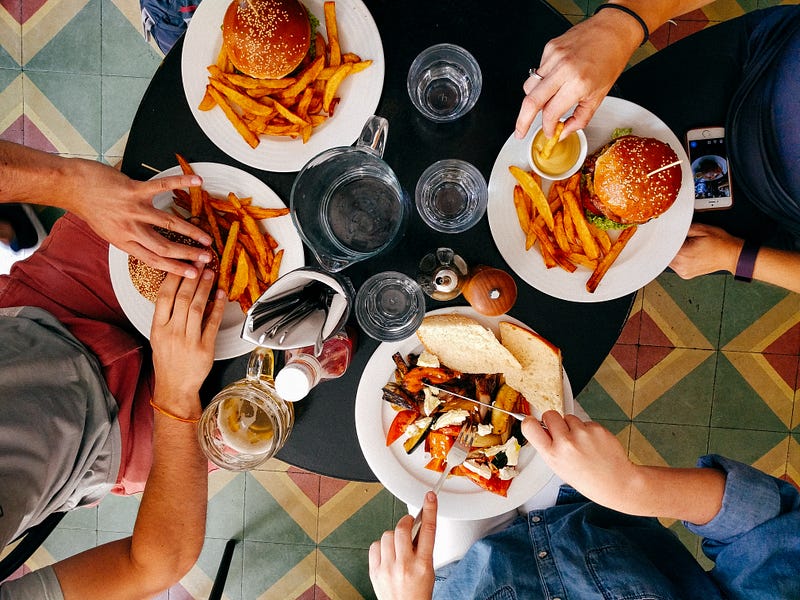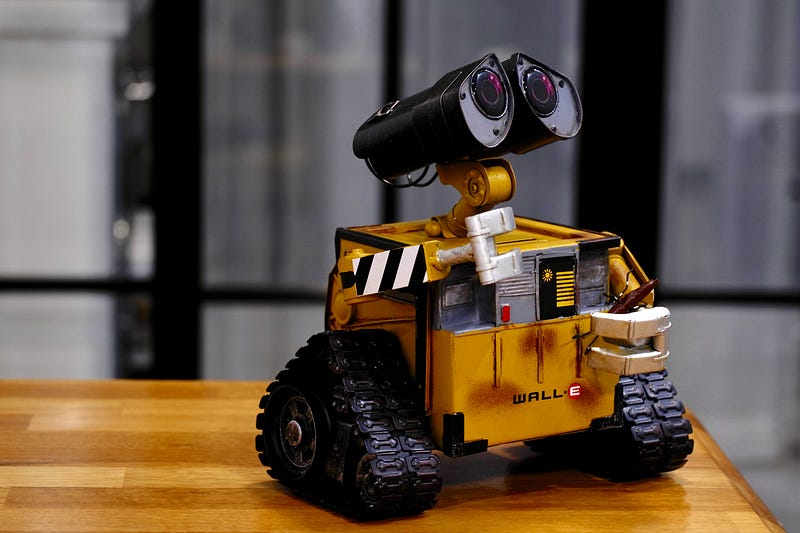What can save us from ourselves?

A giraffe wandering the plains of the African Savanna reaches high into the lush foliage near the top of the tree.
An impala – a small antelope – is left tugging at the few remaining leaves on the much lower branches. It strains to get higher but fails to eat from the out-of-reach limbs.
Over millions of years the giraffe, as a species, has accumulated a large number of key adaptations that helps it survive and reproduce. These adaptations are passed, genetically, onto subsequent generations. They are more likely to survive because they are better suited to the environment in which they live.

If we were to transplant that same animal to the streets of London, the long legs and neck may be of less value, or even a hindrance.
The giraffe, now walking through busy Oxford Street, does not belong in London. It is not adapted to this environment – it is ‘mismatched’.
Over time, evolution, as a process, adapts an animal to environments that last long enough to facilitate change. If that animal is taken out of that environment, those same adaptations are less appropriate.
Our human body, and its features, were adapted for the environment in which it was evolved.
We are ‘maladapted’ for the environment in which we find ourselves.
‘Mismatch illnesses’ are sicknesses, diseases, or disorders, that result from the failure of our lifestyles, and bodies (and potentially minds), to be suitably adapted to our existing environment.
We become ill, and are increasingly injured, in response to living a life to which are incompatible.
What are we adapted for?
According to Daniel Lieberman – famous for his hypothesis that we have evolved many adaptations to facilitate endurance running– we are mismatched to our existing environments.
Much of our physiology – and according to evolutionary psychologistsour psychology – evolved to meet the needs of earlier environments. These conditions either no longer exist, we don’t live in them, or we have mechanisms that modify their effect.
But first, we must understand where we came from, not just as hunter-gathers, but throughout our entire lineage.
The incredibly complex, and continually developing, history of humanscan be boiled down to 5 major transformations:
- A divergence from apes and becoming bipedal (walking upright)
- Arrival of Australopithecus — with evolved adaptations for foraging and the ability to eat a variety of foods, not just fruit
- Arrival of human-like bodies some 2 million years ago. The earliest of the genusHomo, with larger brains and an ability to live as hunter-gatherers
- The spread of early hunter-gathers across the world, and increasingly large brains
- Us, Homo Sapiens, with our capacity for language, and living in larger groups. A relatively fast, wide dispersal across the globe — ultimately the last human species on earth.

A human baby, taken from any time over the last 200,000 years, and brought up in our modern, western environment would be indistinguishable from us.
The evolutionary journey, however, has not stopped for us.
We continue to evolve, culturally. The changes over the last few hundred generations have been dramatic, and lead us to two more (at least) major transformations:
- The Agricultural Revolution. People began to move from hunting together to farming together
- The Industrial Revolution. Machines replace humans in the workforce. Such change was characterised by large mills, and automated machinery, beginning in England during the late 1700s, and impacting all of Europe and the US by the 19th century.
The Agricultural and Industrial Revolutions did not create a different species or subspecies.
However, they did significantly impact the human body: including sleep, work, eating habits, and even defecation.
It is hard to believe there was a time, for adults at least, when we slept when we wanted. Indeed, nighttime sleepwas different: there were multiple stages to sleep during the night and beds became a first wedding gift.
Before we leave such important transformations, there is another, perhaps the most significant cultural change of all. The digital revolution. We are, at present, perhaps too close to fully comprehend the impact on both our physical and psychological state and well-being, but it is profound.
Without a doubt, their are both positive and negative benefits, but only time will provide an unbiased judgement.
Adaptations can cause problems.
Our ancestors were more likely to survive if they craved, actively sought out, and consumed, carbohydrates, and acquired excess fat.
At times of (possibly extended) food shortage, this layer of fat would provide a buffer between energy requirements and calories available in the environment. The individual was subsequently more able to survive until the next available meal.
For the modernhuman, living a comfortable life, where food is usually available in excess supply this adaptation can result in eating too much, too often, exceeding the bodies calorific requirements and gaining excess weight.
Modern diets and physical inactivity are not appropriate for our human body, and lead to what has been described as ‘mismatch’ illnesses.
Our ancestors would not have been sitting around using the Wi-Fi, or watching Netflix and eating doughnuts. As a result, there was no need for adaptations to avoid such conditions either, which also adds to our susceptibility.

Mismatch illnesses
We, as modern humans, are according to research, now prone to illnesses that were previously rare, for example, myopia (nearsightedness) osteoporosis, asthma, high blood pressure, and diabetes.
These ‘mismatch illnesses’ are largely due to much of our body being adapted for the environment in which we evolved.
But, it isn’t straightforward, and leads to further questions:
- How do we identify mismatch illnesses?
- How do we alter our lifestyle to avoid, or recover from, mismatch illnesses?
One clear method to recognise them is to identify health conditions that are present in Western society but are absent amongst hunter-gatherers.
Though there is limited data on the living conditions and health of existing, or past, hunter-gatherers, we can identify strong candidates for mismatch illnesses.
We each inherit thousands of genes, many of which interact with the environment. These were selected over countless generations because they improved the chance of survival and reproduction under particular environmental conditions.
To identify how best to avoid mismatch illnesses, we must therefore, consider the interaction between our genes and our environment.
Aligning our adaptations and our environment
Mismatches occur where a stimuli increases or decreases to a level beyond which we are adapted.
For example,
- Northern Europeans are ill-equipped for the extreme sunshine they encounter in Australia. The pale skin offers little protection against solar radiation and may result in skin cancer.
- We areadapted for a diverse diet, rich in fibre, and low in sugar. A wealth of evidence suggests we subsequently develop heart disease and type 2 diabetes due to a high sugar, low fibre modern diet.
- We crave salt, it is necessary for us to function, but too much is also a problem.
Everything has a balance, and often variety is key.
According to Lieberman, we have choices, we can do nothing and muddle along, but risk a future described in the prophetic carton WALL-E.
Will we be left with a society of ill, highly obese, individuals surviving only as a result of medication and technology?

Do nothing, hope for the best, or change?
The options then are as follows:
Leave it to natural selection, after all, mismatch illnesses appear to have a limited impact on fertility, therefore two key requirements of evolution still exist: heritable variation and reproductive success. We will continue to change, albeit slowly.
Also, new technology and medications are continually being developed that help us cope with our mismatch illnesses.
Perhaps our bodies can adapt to overeating and inactivity — but is this what we want, and can we afford to wait that long?
Leave it to medicine. Will there be a time when eating a plate full of doughnuts will not lead us into calorific credit? Science and medicine will no doubt continue, thankfully, to help us all, but progress is not always quick, or without side effects.
We also see the challenges with prolonged use of medicine. After all, it is widely accepted that we are on the edge of an antibiotic resistance crisis.
Education. According to Benjamin Franklin,“An investment in knowledge pays the best interest.” Public health strategy continues to grow, evolve and improve, providing better information for informed decisions.
Indeed, present public health programmes are far removed from the original shock and awetactics of the 70’s and 80’s and actively provide the knowledge and the skills to better fit their environment.
However, we often ignore advice, and this may still be insufficient to change our outlook and our behaviour.
Change our environment. Illnesses arise as a consequence of the interaction between genes and environment. We are not compelled, as our ancestors were, to eat a health, diverse diet, but we can choose to.
It is difficult to manage a balance between a totalitarian state, mandating exercise and healthy behaviours and eating, and an extreme libertarian society, where any behaviour, no matter how harmful it is to ourselves our fellow humans, is permissible.
There is no single answer.
Lieberman rounds off his work with an important question, if
“cultural evolution got us into this mess, then shouldn’t cultural evolution be able to get us out?”
We can view this as a call to arms, a challenge for us all.
We have a choice whether we live in a manner that is in harmony with how our ancestors lived. But this may require us to either change our immediate environment, behaviour, medicine, or a combination of all three.
I have asthma, which I manage with medication, exercise (a lot of running), and a good diet (mostly). I use probiotics to reduce the change of respiratory infection. There are no guarantees, and I still have health challenges, but it is about reducing the risk.
We can, choose to cycle, walk or run, in place of jumping in the car, and eat more fibre, and less sugar. Each change, even small ones can make a difference, not only to the quality of our lives but also that of our children.
Ultimately, it is our choice, but history dictates that balance is usually the best.
Jeremy Suttonis a writer, speaker, researcher, and ultra-marathoner.
He was awarded his PhD in Human Endurance in 2018, and continues to explore the psychological, physiological, and philosophical factors of extreme endurance through research and running. He has a BSc in Cognitive Science and an MA in Philosophy. You can find more of his work at his website, www.evolutionaryendurance.com
Useful references
See also, within Medium: limits of endurance, adaptation, mental toughness, evolutionary endurance, aerobic fitness, impact of exercise on cognitive impairment, motivation, evolutionary psychology and sport
Balish, S. M., Eys, M. A., & Schulte-Hostedde, A. I. (2013). Evolutionary sport and exercise psychology: Integrating proximate and ultimate explanations. Psychology of Sport and Exercise,14(3), 413–422. doi:10.1016/j.psychsport.2012.12.006
Bramble, D. M., & Lieberman, D. E. (2004). Endurance running and the evolution of Homo. Nature,432(7015), 345–352.
Lieberman, D. (2014). The story of the human body: Evolution, health, and disease. New York: Vintage Books.
Recent Comments